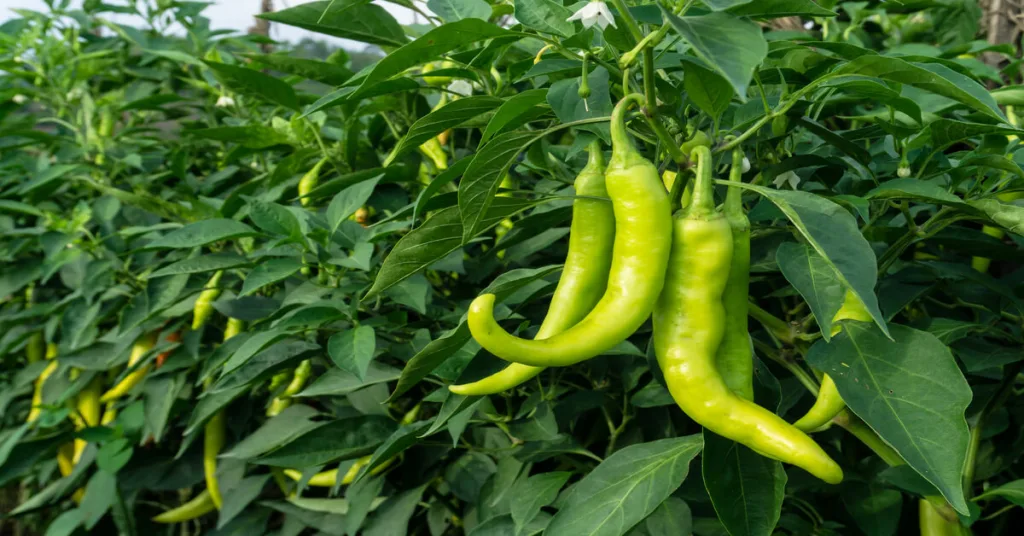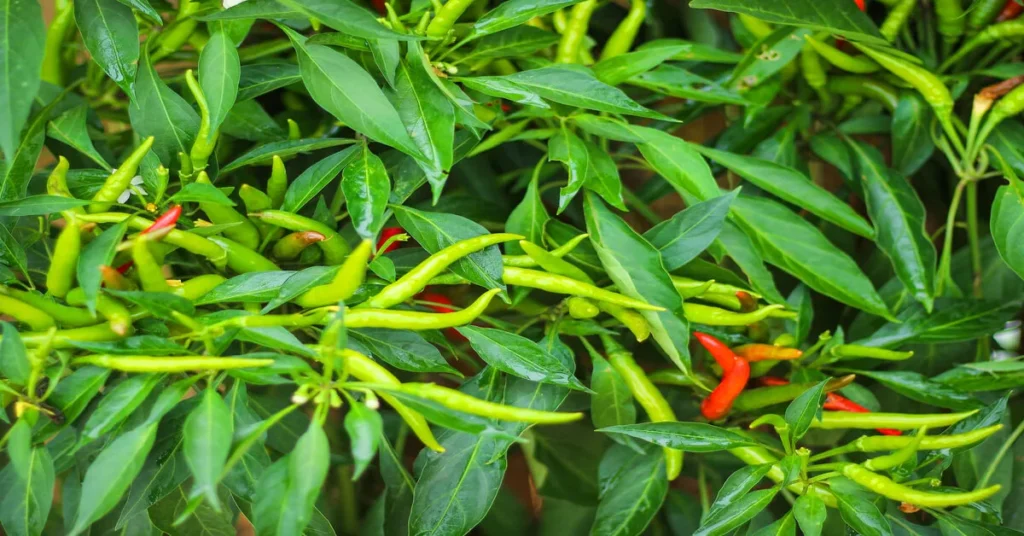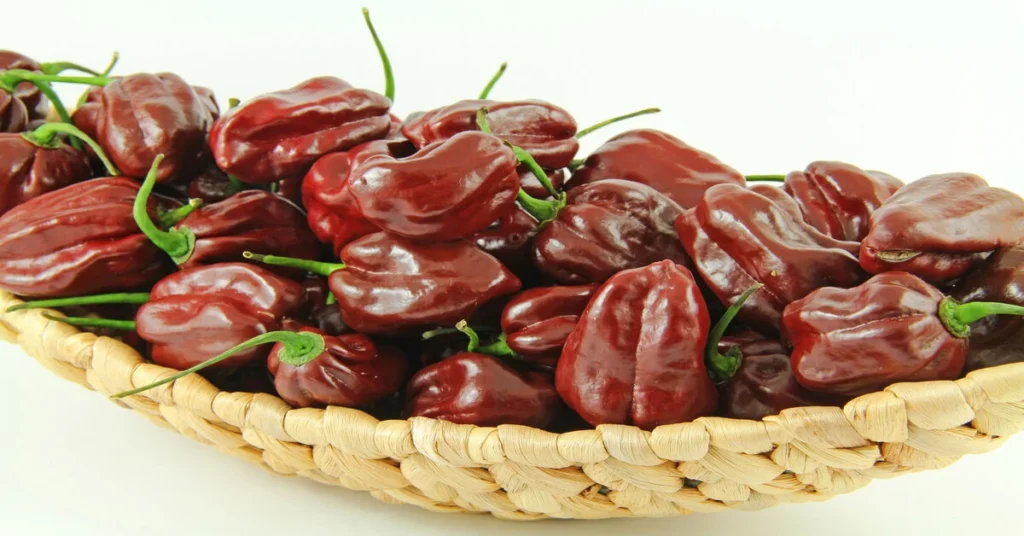Some of the links in this post are affiliate links. This means if you click on the link and purchase the item, I will receive an affiliate commission at no extra cost to you.
With its sharp and intense flavor, a little bit of cayenne pepper (Capsicum annuum) goes a long way in adding heat and depth to dishes.
Whether you’re sprinkling it on your morning eggs or using it to add some spice to your dinner, cayenne pepper is a versatile ingredient that is sure to liven up any meal.
Cayenne Pepper Origin
Cayenne peppers are native to Central and South America and have been consumed by humans at least as far back as 7,500 B.C.
The cayenne pepper is a type of Capsicum annum, which is a species of chili pepper that includes many common varieties such as bell peppers and jalapenos.
The word “cayenne” comes from the Tupi (an aboriginal tribe in Brazil) word quíania, which means “hot pepper.” However, the origin of the cayenne pepper’s name is often misattributed to a municipality in French Guiana, which acquired the name Cayenne due to a misattribution by Europeans. [1]
How hot are Cayenne Peppers?
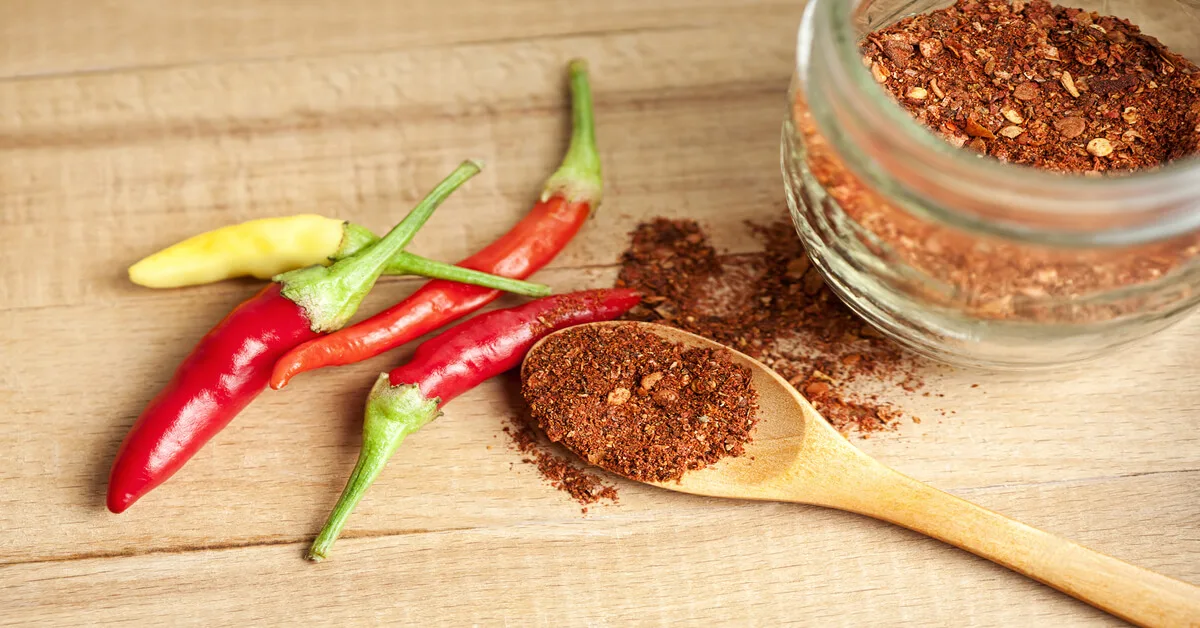
Cayenne peppers are considered medium-hot peppers and have a Scoville rating between 30,000 – 50,000 Scoville heat units (SHU).
The Scoville scale is a measure of the “heat” or spice level of a pepper, with higher ratings indicating a spicier pepper.
Cayennes are significantly hotter than jalapeno peppers, which have a Scoville of 2,500 – 8,000 SHUs, but not as hot as a habanero pepper, which can have a Scoville rating of 150,000 – 350,000 SHUs.
Cayenne Pepper Plant Care
Cayenne pepper plants are the perfect spice for the adventurous gardener and are quite easy to grow and care for.
These cayenne pepper plants can grow quite large, reaching heights of up to 3 feet (1 m) or more. Pepper pods typically range in size from 2-6 inches (5-15 cm) long, but some varieties can grow longer.
Below are a few tips for growing cayenne pepper plants.
Soil
Cayenne peppers prefer well-draining, moist, slightly acidic (pH 6.0-7.0), and organic matter-rich soil. Waterlogged or overly dry soils will cause the leaves to turn yellow.
Watering
Cayenne peppers need about 1-2 inches of water a week with infrequent and deep waterings.
Use a soaker hose or drip irrigation to deliver water to the roots without wetting the leaves, helping to avoid fungal diseases.
Lighting
Cayenne peppers need full sun (6-8 hours of direct sunlight) to grow and produce fruit.
If growing indoors, grow lights may help. Place the lights about 12-18 inches above the plants and keep them on for 14-16 hours per day.
Humidity & Temperature
Cayenne peppers thrive in warm, sunny weather.
Temperatures between 70-85°F (21-29°C) during the day and 60-70°F (15-21°C) at night are ideal.
Cayenne plants may grow well in slightly cooler temperatures, but they may not produce as much fruit.
The ideal relative humidity is between 40-60%. High humidity can lead to fungal diseases, which can damage plants and reduce fruit production.
Fertilizing (NPK)
Most potting mixes come with enough fertilizer to last plants for two weeks.
If your plant mix does not have fertilizer, use a 5-10-10 or 8-16-16 NPK ratio every 2-4 weeks.
When the plant begins to flower, switch to a 9-15-30 NPK (high potassium) fertilizer to encourage fruit growth.
Propagating
Cayenne peppers can be propagated using stem cuttings or seeds. Stem cuttings are easy and reliable, producing genetically identical plants to the parents.
To propagate cayenne peppers using stem cuttings:
- Choose a stem that is at least 6 inches long and has several sets of leaves. Cut the stem just below a leaf node using sharp, clean scissors or pruning shears.
- Remove the lower leaves from the cutting, leaving only the top two or three sets of leaves.
- Next, plant the cutting in a pot filled with a well-draining potting mix that is specifically designed for peppers.
- Water the pot lightly to moisten the potting mix, and then place it in a warm, sunny location to promote rooting.
- Once the cutting has rooted, it can be transplanted into a larger pot or the garden. Roots typically take 7-14 days to develop. Avoid letting the cutting dry out.
Diseases & Pests
Some common diseases that can affect cayenne peppers include bacterial leaf spot, fusarium wilt, mosaic virus, anthracnose, powdery mildew, blight, verticillium wilt, and root rot.
Remove and destroy infected plants and practice good sanitation to prevent the spread of disease.
Fungicides or other chemical controls can help address common diseases, but be sure to read the label carefully.
Common pests include aphids, mites, whiteflies, thrips, cutworms, flea beetles, leafminers, slugs and snails, and fruit worms.
Organic or chemical controls, such as insecticides or insecticidal soaps can help control pests. Avoid applying pesticides when plants are in bloom, as this can harm beneficial insects.
Days to maturity
Cayenne peppers typically take between 70-100 days to mature and produce peppers. This can vary depending on the variety being grown, the growing conditions, and the climate.
Pruning
Cayenne peppers benefit from light pruning throughout the growing season, which helps improve their health and yield. Do not over-prune, as this can stress the plants.
To prune cayenne pepper plants, remove any dead, damaged, or diseased branches and leaves, cutting them back to the nearest healthy growth.
Next, thin out crowded or overgrown areas of the plant, removing any branches that are crossing or rubbing against each other. This will help to improve air circulation and prevent the spread of disease.
Use sharp, clean scissors or pruning shears to make clean cuts. Avoid tearing or damaging the branches, as this can lead to infection.
Cayenne Pepper Plant Stages
Cayenne pepper plants go through several stages of growth, from seedlings to mature plants. The exact number of days may vary, but the stages are summarized below:
- Seedling (Day 0-14): This is the earliest stage of growth when the seed germinates and a small seedling emerges from the soil. At this stage, the seedling will have one or two small leaves and will be very delicate and vulnerable.
- Vegetative growth (Day 14-40): During this stage, the cayenne pepper plant will continue to grow and develop new leaves and stems. The plant will become larger and more robust and will begin to form a more defined shape and structure.
- Flowering (Day 40-55): As the plant matures, it will begin to produce flowers. The flowers will be small and white or yellow and will develop into the fruit of the plant.
- Fruiting (Day 55-70): As the flowers pollinate and develop into fruit, the plant will start to produce cayenne peppers. The peppers will be small and green at first, and will gradually mature and turn red as they ripen.
- Maturation (Day 70-100): Once the peppers have reached maturity, the plant will enter its final stage of growth. Peppers will begin to ripen and turn red. The plant may continue to produce fruit for several weeks or months, depending on the variety and growing conditions.
How to Grow Cayenne Peppers from Seed
Plant cayenne pepper seeds about ¼ inch (0.6 cm) in the potting mix, spacing them about 12 inches (30 cm) apart to allow for adequate growth.
After planting, the seeds should be watered lightly to moisten the soil, and then placed in a warm, sunny location to germinate.
Cayenne peppers typically take 7-14 days to sprout, depending on the variety and the growing conditions.
Once the seeds have sprouted and the seedlings are about 2 inches (5 cm) tall, they can be transplanted into larger pots or the garden.
Consider hardening them off over two weeks to adjust to outdoor conditions.
Growing Cayenne Peppers in Pots
Cayenne peppers are great for growing in pots. Choose a container that is large enough and at least 12 inches (30 cm) in diameter.
The pots should have good drainage holes to allow excess water to drain, as cayenne peppers do not tolerate standing water.
Use a well-draining potting mix designed for peppers. The mix should contain a combination of organic matter, such as compost or peat moss, and a slow-release fertilizer to provide the plants with the necessary nutrients to grow.
Harvesting Cayenne Peppers
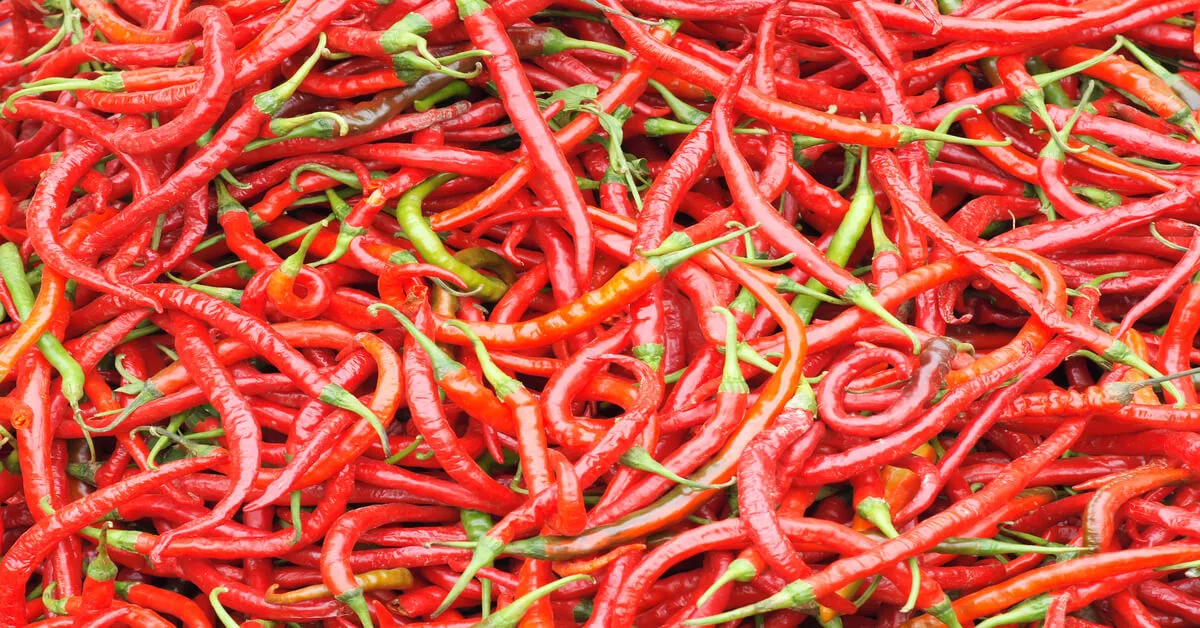
Ripe cayenne peppers will be firm and have a slightly waxy texture when squeezed.
When the peppers are ripe and ready to be picked, cut them off the plant at the stem with scissors or shears, being careful not to damage the plant.
It’s best to harvest cayenne peppers in the morning when they are most ripe and full of flavor.
Be sure to wear gloves when handling the peppers, as they can be quite spicy and may cause irritation to the skin.
After harvesting, the peppers can be used immediately or stored for later use. They can be dried, frozen, or preserved in vinegar to extend their shelf life.
Cayenne Pepper Varieties
There are many types of cayenne peppers, and below are some of the most popular ones to grow:
- Joe’s Long (30-50,000 SHU): Originally from Calabria, Italy, these thin long cayenne peppers (up to 12 inches or 30 cm long) are highly productive and great for fresh eating or drying.
- Long Red Slim: Long, hot chili peppers that are good for making hot sauces, seasoning pickles and salsa, drying, or grounding into powder. Peppers are 5-6 inches (12-15 cm) long and have thin flesh.
- Golden Cayenne: These yellow cayennes are long and thin, with a slight curve and tapered end. The heat is milder, making these popular for pickling and canning.
- Red Ember: These are known for having tremendous flavor with warm lingering heat. Thick and crunchy, perfect for slicing into a salad or stir fry.
- Dragon Cayenne: A hybrid between a Thai and Cayenne chili pepper, these produce a large number of petite peppers. Thrives in long and hot growing seasons.
- Sweet Cayenne: Peppers can grow up to 12 inches (30 cm) long, with crunchy walls that are great for stir-fries or salads. They look hot but are quite mild.
- Orange Cayenne: These peppers are similar to the red kind, but have orange peppers with fruity undertones. These are rare in commercial markets and are usually grown in gardens. They can be eaten raw or cooked, and brighten up any cuisine.
- Red Rocket: Sweet and flavorful, these attractive early-maturing red peppers are excellent for pickling, salsa, or drying.
- Purple Cayenne: Slightly sweeter than regular cayenne peppers, these ornamental peppers are also great for eating. The heat tends to be a bit milder but still has a kick.
Cayenne Pepper Uses
Cayenne peppers are commonly used in cooking to add heat and flavor. They can be used to make chilis, salsa, hot sauce, and various types of curries.
You can also season meat, vegetables, and soups with cayenne peppers. Cayenne peppers are often used in Mexican and Cajun cuisines, including dishes such as chili con carne, jambalaya, and shrimp creole.
Cayenne peppers are also used in traditional medicine to treat pain, digestive issues, and circulation problems. They are sometimes used in topical creams and ointments to treat muscle and joint pain.
Additionally, cayenne peppers are often used in supplements and teas for their potential health benefits.
Some people also use cayenne peppers as natural insect repellants.
References:
[1] Small, E. & National Research Council Canada. (2009). Top 100 Food Plants. Amsterdam University Press.

